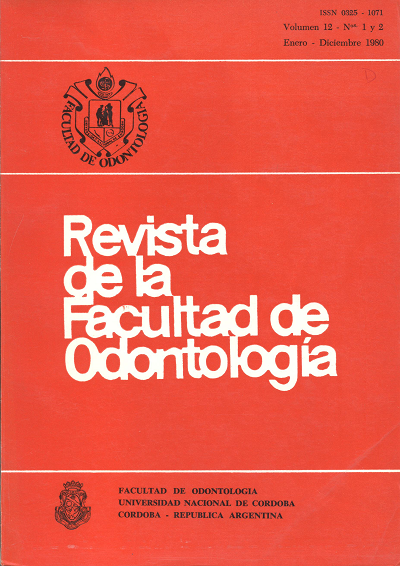Control of sterility on t.f-ie endodontic instrumental used in pulpar necrosis and gangrene
Keywords:
Sterilization, Laboratory EquipmentAbstract
The bacteriological control of sterility on the endodoc:c instrumental was per,forned. Different physical methods of sterilization were used: autoclave, dental oven and quartz beads sterilizer. The materials in these experiments were clasified in five groups: l.: controls; II. Instrumental sterilized with autoclave at 1219 C during 15 minutes. III: instrumental treated with hot air in dental oven at 1409C during 1,30 hours. IV, material sterilized with quartsterilizator at 2609C, 5 y 10 secotmds. V:. material heated in a dental oven at 1409C ·during 1,30 hours and mantanied laterin quartz stelilizator during 10 second. The culture mediillll used was trypticase soy and thiog:ycoliate. The isolation and typification was perfomed with rutin microbio!ogicalmethods.
These studies sho\~ed that the cultures of group I were positive butthat of gronp II were negative. Group III presents a 25% positive, group IV a 19% positive and group V: 100% negative. The differences betwen groups III and IV were not significative. This results demostrate that the us~ of the quartz steriliza!tor is a very usefule'ement for the endodoncist work because avoid the e..xcess of material and the deficiences of tre other conventional metods of sterilization
Downloads
Issue
Section
License
Aquellos autores/as que tengan publicaciones con esta revista, aceptan los términos siguientes:
- Los autores/as conservarán sus derechos de autor y garantizarán a la revista el derecho de primera publicación de su obra, el cuál estará simultáneamente sujeto a la Licencia de reconocimiento de Creative Commons que permite a terceros:
- Compartir — copiar y redistribuir el material en cualquier medio o formato
- La licenciante no puede revocar estas libertades en tanto usted siga los términos de la licencia
- Los autores/as podrán adoptar otros acuerdos de licencia no exclusiva de distribución de la versión de la obra publicada (p. ej.: depositarla en un archivo telemático institucional o publicarla en un volumen monográfico) siempre que se indique la publicación inicial en esta revista.
- Se permite y recomienda a los autores/as difundir su obra a través de Internet (p. ej.: en archivos telemáticos institucionales o en su página web) después del su publicación en la revista, lo cual puede producir intercambios interesantes y aumentar las citas de la obra publicada. (Véase El efecto del acceso abierto).

